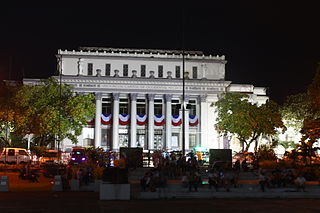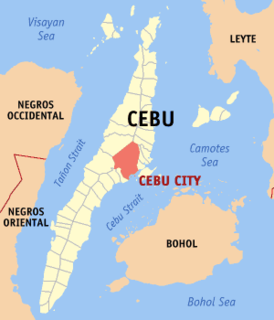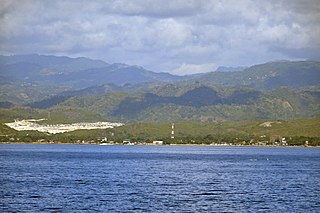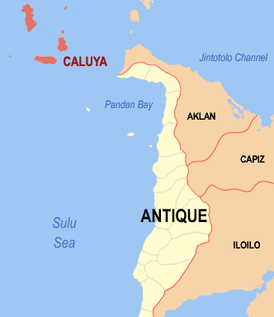
Cebu is a province of the Philippines located in the Central Visayas (Region VII) region, and consists of a main island and 167 surrounding islands and islets. Its capital is Cebu City, the Queen City of the South, the oldest city and first capital of the Philippines, which is politically independent from the provincial government.

Negros Occidental, also known as Occidental Negros or Western Negros, is a province located in the region of Western Visayas, in the Philippines. It occupies the northwestern half of the large island of Negros, and borders Negros Oriental, which comprises the southeastern half. Known as the "Sugarbowl of the Philippines", Negros Occidental produces more than half the nation's sugar output.

Cebu City, officially the City of Cebu, also known as the Queen City of the South, is a 1st class highly urbanized city of the island of Cebu in the Central Visayas Region, Philippines. According to the 2015 census, it has a population of 922,611 people, making it the fifth-most populated city in the nation and the most populous in the Visayas.

Davao Region, formerly called Southern Mindanao, is an administrative region in the Philippines, designated as Region XI. It is situated at the southeastern portion of Mindanao, comprising five provinces: Compostela Valley, Davao del Norte, Davao del Sur, Davao Oriental and Davao Occidental, the newly created province.

Toledo, officially the City of Toledo,, or simply known as Toledo City, is a 3rd class city in the province of Cebu, Philippines. According to the 2015 census, it has a population of 170,335 people.

Camotes Islands is a group of islands in the Camotes Sea, Philippines. Combined area is 236.36 kilometres (146.87 mi). The island group is located east of Cebu Island, southwest of Leyte Island, and north of Bohol Island. It is 34 nautical miles from Cebu City and is part of Cebu. According to the 2015 census, it has a population of 102,996. Population has grown 34.3% since 1990, equivalent to an annual growth rate of 1.19%.
Paltik is a Filipino term for a homemade gun. It is usually manufactured using scrap metal and angle iron. These homemade weapons are usually manufactured in Danao, Cebu, where the production of replicas of known firearms is a cottage industry. The manufacturers claim to be able to replicate any gun, although they prefer to mass-produce six-cylinder .38 caliber revolvers. The Philippine government notes that these firearms are of low quality, even if some are considered as "Class A" or high quality. Danao has the most concentration of factories since the 1940s, but paltik production can also be found in Negros, Leyte, and Mindanao. The Moro Islamic Liberation Front were also known to produce paltik but were unable to upscale their production due to government pressure.

Compostela, officially the Municipality of Compostela,, is a 3rd class municipality in the province of Cebu, Philippines. According to the 2015 census, it has a population of 47,898 people.

San Francisco, officially the Municipality of San Francisco,, is a 3rd class municipality in the province of Cebu, Philippines. According to the 2015 census, it has a population of 55,180 people.

Danao, officially the City of Danao,, or simply known as Danao City, is a 3rd class city in the province of Cebu, Philippines. According to the 2015 census, it has a population of 136,471 people.

Caluya, officially the Municipality of Caluya,, is a 1st class municipality in the province of Antique, Philippines. According to the 2015 census, it has a population of 35,496 people.

Metropolitan Cebu, or simply Metro Cebu,, is the main urban center of the province of Cebu in the Philippines. Metro Cebu is located along the central eastern portion of the island including the nearby island of Mactan. It accounts for 20 percent of the land area and 61.5 percent of the population of the entire island of Cebu.

Tourism is an important sector for Philippine economy. In 2015, the travel and tourism industry contributed 10.6% to the country's GDP. Philippines is an archipelagic country composed of 7,641 islands with 82 provinces divided in 17 regions. The country is known for having its rich biodiversity as its main tourist attraction. Its beaches, heritage towns and monuments, mountains, rainforests, islands and diving spots are among the country's most popular tourist destinations. The country's rich historical and cultural heritage, including its festivals and indigenous traditions, are also one of the attractions of Philippines. Popular destinations among tourists are Cebu, Boracay, Palawan, Siargao, and many more.

Pugalo is a barangay in Alcoy, Cebu, Philippines. It is known for its large deposit of dolomite mineral. With a size of 571 hectares of mining claims and an estimated balance of deposits at 220 million metric tons, since the extraction began in 1981, it is currently the biggest dolomite mining found in Asia. The mining company, Philippine Mining Service Corporation, is a private company wholly owned by JFE Mineral Company, part of JFE Steel Corporation of Japan.

The Roman Catholic Archdiocese of Cebu is a Roman Rite archdiocese of the Catholic Church in the Philippines and one of the ecclesiastical provinces of the Catholic Church in the country. It is composed of the entire civil province of Cebu. It is the Mother Church of the Philippines. The jurisdiction, Cebu, is considered as the fount of Christianity in the Far East.

The following outline is provided as an overview of and topical guide to the Philippines:
Carlos A. Gothong Lines, popularly known as CAGLI and formerly once known as simply Gothong Lines, is a passenger and cargo ferry company based in Cebu, Philippines. CAGLI was formerly a part of WG&A SuperFerry, a company in January 1996 which served 23 major provincial ports throughout the Philippines and was the first domestic shipping company in the country to be certified by the International Safety Management Code standard. CAGLI, William Lines and Aboitiz Shipping formed was the biggest merger in the Philippine shipping industry.

Naga, officially the City of Naga or simply known as Naga City, is a 5th class city in the province of Cebu, Philippines. According to the 2015 census, it has a population of 115,750 people.
DMCI Homes is the real estate arm of DMCI Holdings through its wholly owned subsidiary DMCI Project Developers, Inc. (PDI). It was incorporated and registered with the Securities and Exchange Commission (SEC) on April 27, 1995. It ranked #146 in the Business World Top 1000 Corporations for 2014.

Panay Railways Inc. is a government-owned and controlled corporation of the Philippines headquartered in La Paz, Iloilo City on the island of Panay. It is a subsidiary of Phividec Railways Inc. of the Philippine Veterans Investment Development Corporation (Philvedec). The railway current doesn't operate any trains but it leases the property that it owns and the revenue is used to defray the personnel and administrative costs incurred from looking after its assets.



















